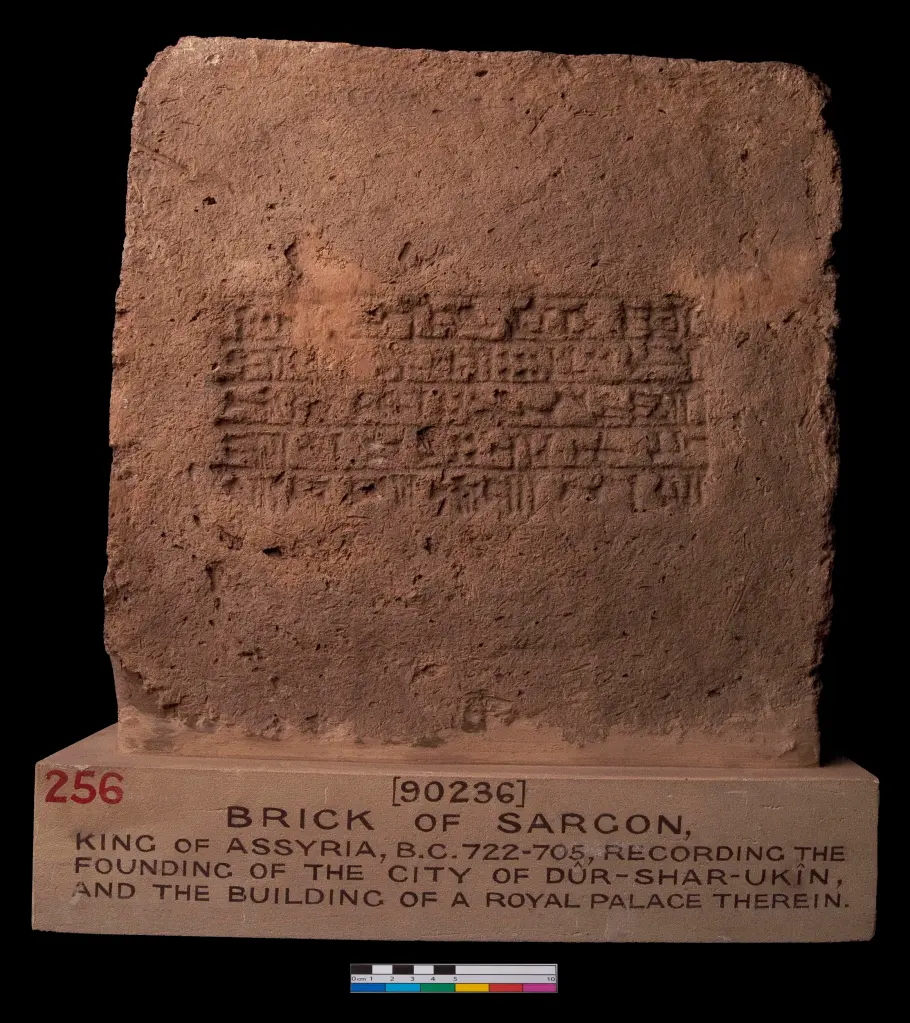
In the year that the supreme commander, sent by Sargon king of Assyria, came to Ashdod and attacked and captured it – at that time the LORD spoke through Isaiah son of Amoz. (Is 20:1 ESV)
For many years an Assyrian king named Sargon was unknown to history apart from this verse.1 Bible scholars and commentators prior to the mid-nineteenth century usually interpreted Sargon as an alternate name for another Assyrian king, either Shalmaneser2, Sennacherib3, or Essarhaddon4. Of course, when Sargon’s palace at Dûr-Sharrukin, (literally, “Sargon’s Fortress”) was discovered at modern Khorsabad in 1843, the historicity of Isaiah’s Sargon was affirmed. Interestingly, Alan Millard, professor of Hebrew and Semitic Languages at Liverpool University, notes that the way Isaiah spelled Sargon’s name is an indicator that the prophet lived at the time of Sargon II, and that the book was not penned hundreds of years later. Isaiah spells the Assyrian king’s name using the Aramaic, SRGN, the language spoken by the Assyrians at that time. An Aramaic seal imprint discovered at Khorsabad spells it in the same way. If it was written during the Babylonian exile, one would expect it to read, SHRKN, the way the Babylonian’s spelled it.5
Sargon’s Rise to Power

Sargon may have come to power as the result of a rebellion against his predecessor, Shalmaneser V. He took the throne name Sargon (lit. “legitimate king”), no doubt hoping to reign in the tradition of the great Sargon, king of Akkad (ca. 2334 – 2279 BC). These facts have led some scholars to conclude he was a usurper.6 However, the idea of Sargon being a usurper is based mainly on the meaning of his name and the silence of Assyrian sources regarding his origin. French historian Josette Elayi on the other hand notes, “Currently the opinion that Sargon was not a usurper is better supported. In fact, the filiation is indicated in two Sargon inscriptions where he was clearly presented as the son of Tiglath Pileser III, king of Assyria. He also referred to his ‘royal fathers’ in the so-called Borowski Stela, probably originating from Hamath.”7
Like other ancient kings, Sargon claimed his kingship was ordained by the gods:
“Sargon, deputy of Enlil…desired by Ashur, chosen of Anu and Dagan; great king, mighty king, king of the world, king of Assyria, king of the four quarters (of the world), favorite of the great gods; legitimate shepherd, to whom Ashur (and) Marduk granted an unrivaled kingship…”8
While he was unknown to history at one time, we now know more about his reign than other Assyrian kings. In addition to his royal inscriptions, over 1100 cuneiform letters can be dated to Sargon’s reign, some of them authored by Sargon himself.9 These, along with the excavations of his capital city at Khorsabad paint a picture of a powerful king who reigned from ca. 722/721 to 705 BC, expanding the Assyrian empire through conquest.

Sargon’s Capital City
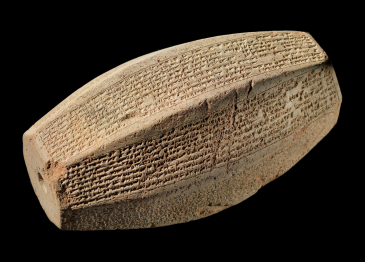
After his accession to the throne, Sargon selected a site for his new capital city located northeast of Nineveh at the foot of Mount Musri. He evicted the people living in the village there, relocating them to the district of Nineveh, and set about to construct his new city which he called Dûr-Sharrukin, the Fortress of Sargon.10 Sargon describes constructing the temples, palace, and gates of Dûr-Sharrukin this way:
“In the month Ab, the month of Gibil’s (the fire god) descent, who dries up the fresh meadows, the time for setting the foundation for city and temple, I laid its foundation and placed its brickwork. I erected firmly founded shrines therein, founded like bedrock, for Ea, Sin, Ningal, Adad, Shamash, (and) Ninurta. By their lofty command, I built as my royal dwelling a palace of ivory, ebony, boxwood, sissoo, cedar, cypress, juniper, and pistachio. I constructed in front of their doors a bit-h˘ ilani, a copy of a palace of the land of Hatti, and I laid beams of cedar and cypress on them…I set as the circumference of its (i.e., the city) wall, and I laid its platform on a firm foundation of massive (lit. high) mountain rock. I opened eight gates to the eight winds, front and back, on both sides.”11
Paul-Émile Botta rediscovered Dûr-Sharrukin in 1843 when a man from Khorsabad invited him to come and see the sculptures that the residents who dug foundations for their homes occasionally unearthed. Botta was amazed at the finds from the trench he dug, and returned to excavate the city from 1858 to 1865. Further excavations were conducted by Victor Place from 1928 to 1935 and by Fuad Safar in 1957.
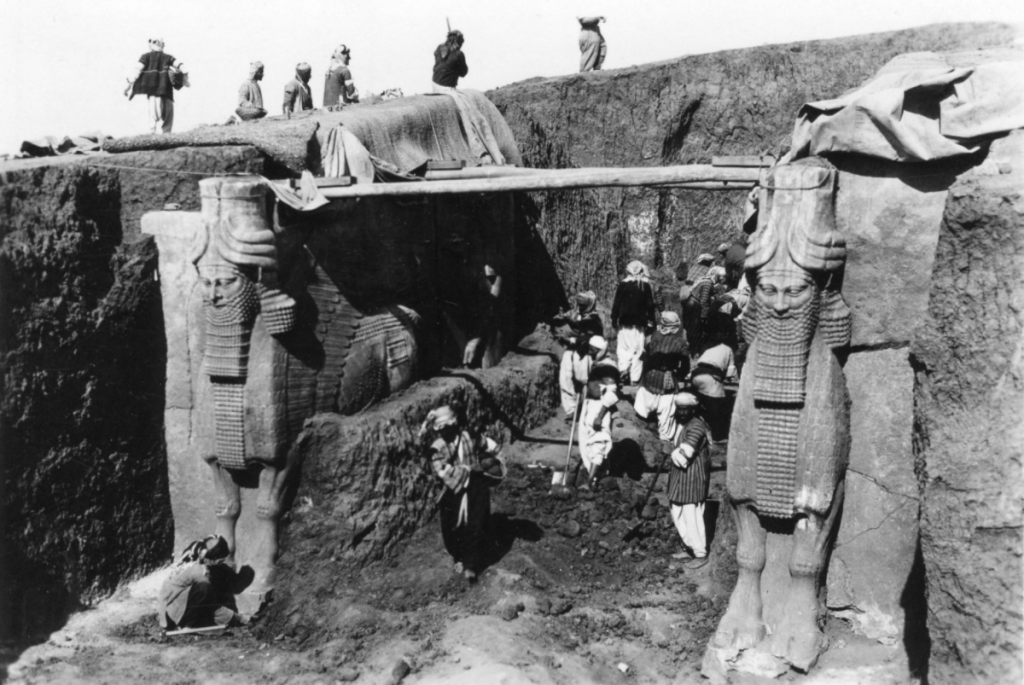
These excavations unearthed Sargon’s magnificent city, with a vast palace containing some 200 rooms and courtyards.12 Sargon’s annals were discovered on the walls in several rooms of his palace, having been inscribed there to commemorate the inauguration of his palace.13 Gigantic sculptures of winged bulls with human heads (a creature called a lamassu) guarded the entrances to the city and to the palace. The capital city was not yet fully finished when Sargon fell in battle in 705 BC. His son, Sennacherib, abandoned the construction of Dûr-Sharrukin and moved the Assyrian capital to Ninevah.14
Sargon’s Attack on Ashdod
Sargon’s sole mention in the Bible is related to his attack on the city of Ashdod. As happens so often, archaeological findings illuminate the biblical text by providing background information. In his royal inscriptions Sargon gives the reason for his campaign against Ashdod. The king of the city had withheld his tribute from Sargon and attempted to convince neighboring kings to join in the rebellion. Sargon deposed Azuri, the king of Ashdod, placing his brother Ahimiti on the throne. The people of Ashdod promptly deposed Ahimiti and appointed a man named Yadna as their king. Sargon explains his response to these developments:
“In my rage, I marched to Ashdod, his royal city, with my personal chariot and my horsemen, who even in friendly areas do not leave my side. I besieged Ashdod, Gath, and Ashd[od-yam,] and captured (them).”15
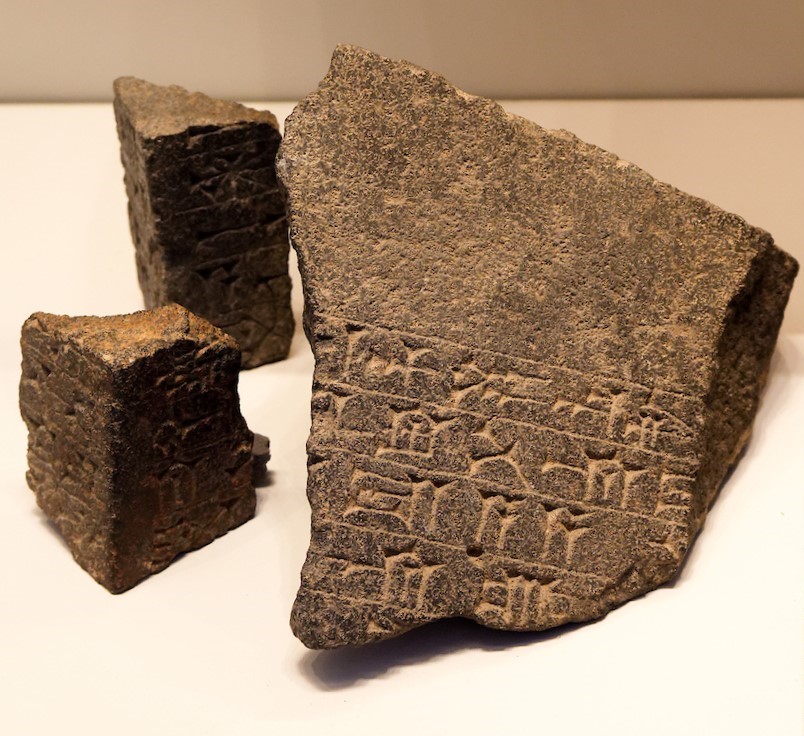
So who conquered Ashdod: Sargon himself, as he claims, or the supreme commander of the Assyrian army, as Isaiah states? There are several ways to explain this discrepancy. The supreme commander could have been the one who physically captured Ashdod while Sargon, who was leading the entire campaign in Canaan, was at nearby Gath. Mordecai Cogan provides another explanation: “Assuming the accuracy [of Isaiah]… the claim of a royal victory at Ashdod is another example of the appropriation by the king of an achievement accomplished by the army.”16
In 1953, part of a victory stele commemorating Sargon’s conquest of the city was discovered at Ashdod.17 Excavations also revealed a significant destruction layer and mass graves, both of which have been attributed to Sargon’s attack on Ashdod.18
Sargon’s Attack on Israel?
Sargon claimed credit for another momentous biblical event. In 2 Kings 17:1–6, we read of the fall of the northern Kingdom of Israel, which occurred in 723 or 722 BC.19 King Hoshea, was initially a vassal to Shalmaneser V, the king of Assyria, but rebelled, turning to So, King of Egypt (likely Pharaoh Osorkon IV) for help. “Then the king of Assyria invaded all the land and came to Samaria, and for three years he besieged it. In the ninth year of Hoshea, the king of Assyria captured Samaria, and he carried the Israelites away to Assyria and placed them in Halah, and on the Habor, the river of Gozan, and in the cities of the Medes” (v. 5–6)
In multiple inscriptions20 Sargon claims that he was the one who conquered Israel, deporting the people and resettled Samaria with those from other lands he had conquered. For example, in the Calah Summary Inscription, Sargon boasts:
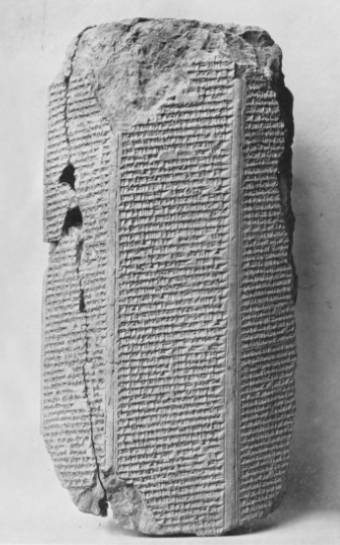
“[The Sa]marians, who had come to an agreement with a [hostile?] king not to do service or to render tribute to me, did battle. In the strength of the great gods, my lords, I fought with them; 27,280 people, together with [their] char[iots] and the gods in whom they trust, I counted as spoil…I organized a royal contingent from among them and the rest of them I settled in Assyria. I resettled Samaria more (densely) than before (and) brought there people from the lands of my conquest.”21
In Sargon’s inscription, we see confirmation of Hoshea’s rebellion and his reliance on a hostile king (So, King of Egypt – 2 Ki 17:4), as described in the Bible. How do we make sense of Sargon’s claim to have captured Samaria, while the Bible seems to attribute it to Shalmaneser V?
One possible solution is that the conquest of Israel was begun under Shalmaneser, and finished under Sargon. Thus, Shalmaneser is named as the Assyrian king who invaded the land and imprisoned Hoshea (2 Ki 17:3-4), while Sargon is the unnamed “king of Assyria” who captured Assyria and carried off the Israelites (2 Ki 17:6). Another explanation is that Shalmaneser conquered Israel, but died shortly afterward and Sargon, writing later in his reign, took credit for the conquest. Kenneth Kitchen explains:
“Following Shalmaneser’s very brief reign, which ended before any account of his last year could be monumentalized, Sargon II replaced him…and subsequently claimed the capture of Samaria for himself, much later in his reign. This was certainly a propaganda exercise, to cover the gap in military successes that would otherwise disfigure the accounts of his reign. The mere three months of his “accession year” were not adequate to run a campaign, nor the season suitable; and internal strife occupied the first year of his reign. So the later annalists had to cover this over by attributing Shalmaneser’s capture of Samaria to Sargon.”22
Sargon’s Death
Assyrian texts indicate Sargon died while on a military campaign. Sennacherib, his son notes that his father was “killed in enemy country” and that he was not “buried in his house.”23 Apparently Sargon’s body was not recovered after the enemy attacked the Assyrian camp. The fact that his father’s body was never found and that he was not given a proper burial in his royal city was seen as a curse by their gods. Sennacherib believed his father’s death was divine punishment for neglecting the Mesopotamian god Ashur, and quickly abandoned Dûr-Sharrukin, setting up his capital at Ninevah.24
Conclusion
At one time Sargon was unknown to history apart from one verse Isaiah; we now know much about his life and reign. Some of the details from Assyrian records align with details in the biblical text; apparent discrepancies can be plausibly explained. In the end, as we have seen so often before, archaeology illuminates and affirms events in biblical history.
Cover Photo: Relief of Sargon II from Khorsabad, currently housed at the Museo di Antichità in Turin, Italy. Credit: Jona Lendering, Livius.org, CC0 1.0 Universal
End Notes
1 I have seen the claim repeated by various Christians that early skeptics used to believe the Bible was in error because Sargon was unknown to history apart from the reference in Isaiah 20:1. However, I cannot find any quotes attributed to these supposed skeptics. I wonder whether this is an urban myth that has been repeated without due diligence to fact-check the truth of the claim. If anyone can point me to an early skeptic who believed the Bible to be in error because there was “no Sargon” I would be grateful if you would let me know.
2 Robert MacCulloch, Lectures in Isaiah, Vol. 2. (London: J. Johnston et. all, 1794), p. 199. Online: https://archive.org/details/lecturesonprophe02macc/page/198/mode/2up?view=theater (Accessed Feb. 16, 2024)
3 William Day, An Exposition of the Book of the Prophet Isaiah. (London: Joshua Kirton, 1654). Online: https://quod.lib.umich.edu/e/eebo2/A37290.0001.001/1:5.20.1?rgn=div3;view=fulltext (Accessed Feb. 16, 2024)
4 Steven W. Hollloway notes that eighteenth century writers, such as Perizonius, Kalinsky, and Michaelis identified Sargon with Essarhaddon. See Mark W. Chavalas and K. Lawson Younger, Jr, eds. Mesopotamia and the Bible. (London: Sheffield Academic Press Ltd, 2002), 69-70.
5 Philippe Bohstrom, “Isaiah the Prophet, Man or Biblical Myth: The Archaeological Evidence.” Haaretz, March 19, 2018. https://www.haaretz.com/archaeology/2018-03-19/ty-article-magazine-ext/isaiah-the-prophet-man-or-myth/00000180-179b-db53-a3aa-179f1ff00000 (Accessed Feb. 16, 2024).
6 A. Kirk Grayson, “Sargon,” In The Anchor Bible Dictionary, ed. D.N. Freedman. (New York: Doubleday, 1992), 7824.
7 Josette Elayi, Sargon II, King of Assyria. (Atlanta, SBL Press, 2017), 27.
8 Amitai Baruchi-Unna and Mordechai Cogan, “The Cylinder Inscription of Sargon II: A Study in the Relationship between Text Composition and City Construction.” Israel Museum Studies in Archaeology 9, 2018–2019, 42. Online: https://museum.imj.org.il/journal/archive/2018-2019/pdf/cylinder.pdf (Accessed Feb. 16, 2024).
9 Josette Elayi, Sargon II, King of Assyria. (Atlanta, SBL Press, 2017), 6.
10 Amitai Baruchi-Unna and Mordechai Cogan, “The Cylinder Inscription of Sargon II: A Study in the Relationship between Text Composition and City Construction.” Israel Museum Studies in Archaeology 9, 2018–2019, 45. Online: https://museum.imj.org.il/journal/archive/2018-2019/pdf/cylinder.pdf (Accessed Feb. 16, 2024).
11 Baruchi-Unna and Cogan, 46.
12 “The Palace of Sargon II.” The Louvre. https://www.louvre.fr/en/explore/the-palace/the-palace-of-sargon-ii (Accessed Feb. 19, 2024)
13 Mordecai Cogan, The Raging Torrent: Historical Inscriptions from Assyria and Babylonia Relating to Ancient Israel. (Jerusalem: Carta, 2015), 99.
14 “Excavations At Khorsabad,” The University of Chicago Institute for the Study of Ancient Cultures: West Asia and North Africa. Online: https://isac.uchicago.edu/research/projects/excavations-khorsabad (Accessed Feb. 16, 2024)
15 Mordecai Cogan, The Raging Torrent: Historical Inscriptions from Assyria and Babylonia Relating to Ancient Israel. (Jerusalem: Carta, 2015), 101.
16 Cogan, 109.
17 Hayim Tadmor, “Philistia under Assyrian Rule.” The Biblical Archaeologist, Sep., 1966, Vol. 29, No. 3 (Sep., 1966), 95. https://www.jstor.org/stable/3211004 (Accessed Aug. 20, 2023).
18 David Noel Freedman, “A Second Season at Ashdod.” The Biblical Archaeologist, Dec., 1963, Vol. 26, No. 4 (Dec., 1963), 138. https://www.jstor.org/stable/3211042 (Accessed Aug. 20, 2023)
19 For a detailed discussion surrounding the debate about whether Samaria fell in 723 BC, during the reign of Shalmaneser V (727-722 BC) or in 722 BC during the reign of Sargon II (722-705 BC), see ch. 8, “The Siege and Fall of Samaria in The Mysteries Numbers of the Hebrew Kings, by Edwin Thiele and Roger Young’s article, “When Was Samaria Captured? The Need for Precision in Biblical Chronologies.” (JETS, 44/4, December 2004, 577-95), available here: http://www.rcyoung.org/articles/samaria.html.
20 Sargon claims to have defeated and deported the Israelites from Samaria in the Khorsabad Summary Inscription, the Calah summary Inscription, and the Khorsabad Annals. See Mordecai Cogan, The Raging Torrent: Historical Inscriptions from Assyria and Babylonia Relating to Ancient Israel. (Jerusalem: Carta, 2015), 90–101.
21 Mordecai Cogan, The Raging Torrent: Historical Inscriptions from Assyria and Babylonia Relating to Ancient Israel. (Jerusalem: Carta, 2015), 96.
22 K. A. Kitchen, On The Reliability of the Old Testament. (Grand Rapids: Wm. B. Eerdmans Publishing Co., 2006), 39.
23 Josette Elayi, Sargon II, King of Assyria. (Atlanta, SBL Press, 2017), 210.
24 “The Death of Sargon.” https://archeologie.culture.gouv.fr/khorsabad/en/death-sargon (Accessed Feb. 19, 2024).

